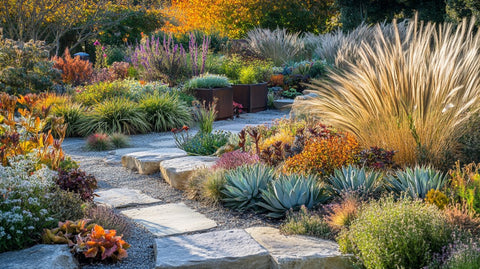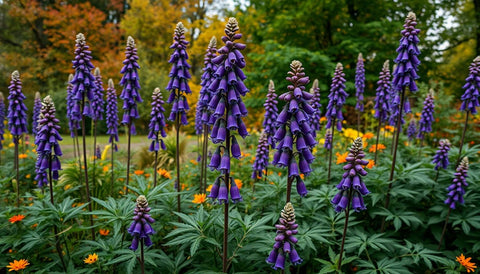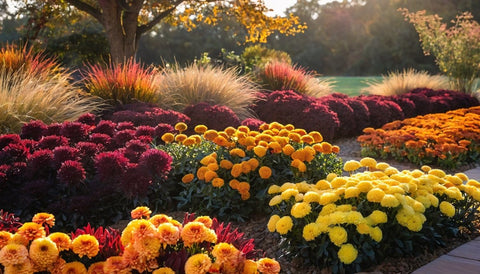Why Go Drought-Resistant This Fall?
Fall offers us a unique opportunity to enjoy a flourishing garden while also being mindful of our water usage. Drought-resistant plants not only save water but also provide a burst of autumn color, extending the growing season without the hassle of constant care. In this post, we'll explore how to design your ideal fall garden using drought-resistant plants that look great and thrive with minimal resources.
Understanding Drought-Resistant Plants
What Are Drought-Resistant Plants?
Simply put, drought-resistant plants have adapted to survive in low-water conditions. These plants often feature deep roots, waxy leaves, or adaptations that minimize water loss. However, a common misconception is that they don't need any water at all. While these plants are hardy, they still benefit from occasional watering, especially right after planting.

The Importance of Native Species
When selecting drought-resistant plants, consider choosing native species. Native plants are typically well-adapted to your local climate and soil conditions, contributing positively to local ecosystems and providing habitat for wildlife.
Planning Your Fall Garden
Assess Your Space
Before diving into planting, take stock of your garden space. Assess how much sun or shade different areas receive, the type of soil you have, and how well the area drains. Understanding these elements will guide your plant selections and layout choices.
Designing Your Garden
A well-planned garden layout is essential for both aesthetics and plant health. Think about layering your plants—from tall ornamental grasses at the back to shorter flowers at the front. Group plants by their water and sunlight needs to create a harmonious and thriving space.
Seasonal Plant Choices
For fall gardening, look for plants that bloom or provide vibrant foliage during this season. Not only do these plants offer visual interest, but they also tend to attract wildlife, making your garden alive with activity.
Top Drought-Resistant Plants for Fall Gardens
Must-Have Drought-Resistant Plants
- Succulents: These plants store water in their leaves and require very little maintenance, making them perfect for busy gardeners.
- Native Wildflowers: Species like Aster and Rudbeckia not only withstand drought but also add beautiful colors to your garden.
- Ornamental Grasses: Grasses like Pennisetum and Miscanthus can add height and texture with minimal water requirements.
Spotlight on Local Favorites
Consider incorporating local native plants as they provide essential nutrients to the ecosystem and often require less upkeep. Explore plant nurseries or local gardening groups to discover what thrives in your area during the fall.

Soil Preparation and Planting Techniques
Healthy Soil Equals Happy Plants
Before planting, ensure your soil is well-prepared. Good soil health dramatically enhances a plant's ability to withstand drought conditions. Test your soil’s pH and texture, then amend it with organic matter, such as compost, to improve drainage and nutrient retention.
Planting Best Practices
When planting, dig holes larger than your plant’s root ball to give it room to establish itself. Space your plants according to their growth habits to prevent overcrowding and competition for moisture.
Mulching Techniques
Don't underestimate the power of mulch! Apply a layer of organic mulch around your plants to help retain moisture, suppress weeds, and maintain a consistent soil temperature.
Maintenance Tips for Your Fall Garden
Watering Wisely
Although drought-resistant does not mean "no water," it’s crucial to understand how to water effectively. Deep, infrequent watering encourages deeper root growth, allowing plants to tap into moisture reservoirs below the surface. Typically, watering once every two weeks should suffice, adjusting based on your region's rainfall.
Fertilization Guidelines
While drought-resistant plants generally need less fertilizer, a light application in spring can give them a boost. Opt for slow-release fertilizers that feed plants gradually over time.

Pest Control and Seasonal Cleanup
Keep an eye out for pests, but remember that healthy plants are often resistant to infestations. For seasonal cleanup, remove dead foliage and any plant debris to prevent disease and pest issues as winter approaches.
Benefits of a Drought-Resistant Fall Garden
Ecological Advantages
Creating a drought-resistant garden isn't just beneficial for your home; it's also ecologically friendly. These gardens support local wildlife, attract pollinators, and help maintain biodiversity.
Economic Benefits
With lower water usage, you’ll see a decrease in your water bills and less money spent on yard maintenance. Plus, using hardy plants means fewer replacements and garden supplies in the long run.
Aesthetic Appeal
A beautifully designed drought-resistant garden can enhance the aesthetic value of your property. Seasonal colors and textures will keep your garden looking lively from late summer into fall and even winter!

Conclusion: Time to Get Gardening!
Creating a drought-resistant fall garden is not just a smart choice for water conservation; it’s an opportunity to enjoy a vibrant, low-maintenance outdoor space. Don’t hesitate to start planning your own garden to reap the benefits of sustainability and beauty all autumn long.
So, are you ready to start your fall garden journey? Share your thoughts or questions in the comments below!
Additional Resources
Check out these resources for more information:






























Comments (0)
There are no comments for this article. Be the first one to leave a message!